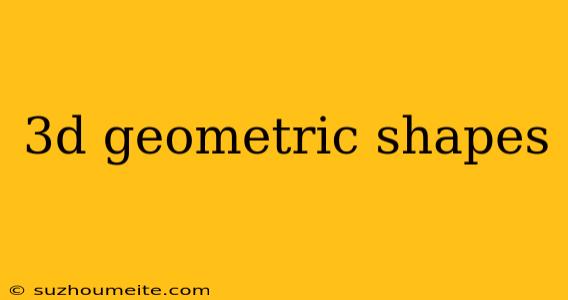3D Geometric Shapes: Understanding the Basics
Introduction
In mathematics, geometry is a branch that deals with the study of shapes, sizes, and positions of objects. 3D geometric shapes are a fundamental concept in this field, and they play a crucial role in various areas of science, engineering, art, and design. In this article, we will explore the basics of 3D geometric shapes, their definitions, and their properties.
Types of 3D Geometric Shapes
There are several types of 3D geometric shapes, each with its unique characteristics and properties. Here are some of the most common ones:
Polyhedra
A polyhedron is a 3D shape with flat polygonal faces and straight edges. The most common polyhedra are:
- Tetrahedron (4 faces, 6 edges, 4 vertices)
- Cube or Hexahedron (6 faces, 12 edges, 8 vertices)
- Octahedron (8 faces, 12 edges, 6 vertices)
- Dodecahedron (12 faces, 30 edges, 20 vertices)
- Icosahedron (20 faces, 30 edges, 12 vertices)
Prisms
A prism is a 3D shape with two identical faces that are polygons, connected by a rectangular solid. Examples of prisms include:
- ** Rectangular Prism** (6 faces, 12 edges, 8 vertices)
- Triangular Prism (5 faces, 9 edges, 6 vertices)
Pyramids
A pyramid is a 3D shape with a polygonal base and triangular faces that meet at the apex. Examples of pyramids include:
- Square Pyramid (5 faces, 8 edges, 5 vertices)
- Triangular Pyramid (4 faces, 6 edges, 4 vertices)
Cylinders
A cylinder is a 3D shape with two parallel and circular bases connected by a curved surface. Examples of cylinders include:
- Circular Cylinder
- Elliptical Cylinder
Cones
A cone is a 3D shape with a circular base and a curved surface that tapers to a point. Examples of cones include:
- Circular Cone
- Elliptical Cone
Spheres
A sphere is a 3D shape with a continuous curved surface, where every point on the surface is equidistant from the center.
Properties of 3D Geometric Shapes
3D geometric shapes have various properties that define their characteristics. Some of the most important properties include:
- Faces: The flat surfaces of a 3D shape
- Edges: The lines where two faces meet
- Vertices: The points where three or more edges meet
- Surface Area: The total area of all the faces
- Volume: The amount of space inside the shape
- Axis of Symmetry: A line or point that divides the shape into two identical halves
Real-World Applications
3D geometric shapes have numerous applications in various fields, including:
- Architecture: Designing buildings, bridges, and other structures
- Engineering: Designing machines, mechanisms, and devices
- Art and Design: Creating sculptures, models, and digital artwork
- Science: Studying the structure of molecules, crystals, and celestial bodies
- Computer Graphics: Creating 3D models and animations for movies, games, and simulations
Conclusion
In conclusion, 3D geometric shapes are a fundamental concept in mathematics and have numerous applications in various fields. Understanding the basics of these shapes, their definitions, and their properties is essential for problem-solving and critical thinking. By exploring the world of 3D geometric shapes, we can gain a deeper appreciation for the beauty and complexity of the world around us.
